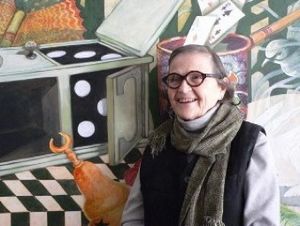Ellen Lanyon facts for kids
Ellen Lanyon (December 21, 1926 – October 7, 2013) was a talented painter and printmaker. She was born in Chicago, Illinois, USA. Ellen studied art at several famous schools. These included the School of the Art Institute of Chicago (SAIC) and the University of Iowa School of Art and Art History. She also studied art restoration in London at the Courtauld Institute of Art. Her artworks are now in many big museums across America. You can find her pieces at places like the Art Institute of Chicago and the Metropolitan Museum of Art.
Contents
Ellen Lanyon's Early Life
Ellen Lanyon was born in Chicago. When she was a child, she visited the Chicago World's Fair in 1933. This visit was a very unusual experience for her. It made a strong impression on her as an artist.
High School and First Job
Ellen went to Hyde Park High School. While she was there, she had a part-time job. She worked as an artist in a factory where her father worked. Her job was to draw machine parts very carefully. She later said that this job helped her learn to draw lines with great detail.
Starting Her Art Journey
In 1944, Ellen got to join a special art program. It was at the Ox-Bow School of Art. This experience truly inspired her. It made her want to become a painter and a printmaker.
In 1948, she finished her art degree (BFA) at the School of the Art Institute of Chicago. That same year, she married Roland Ginzel, who was also an artist.
Standing Up for Artists
Ellen also became a leader of a group called Exhibition Momentum. This group started in 1948. They protested against the Art Institute of Chicago's yearly art show. The Art Institute had stopped students from entering their exhibition. So, Ellen and other students worked together. They invited artists and experts from New York to judge their own show. After three years, the Art Institute changed its rules. They started letting students enter their exhibition again.
Ellen continued her studies. She earned her master's degree (MFA) from the University of Iowa in 1950. She also studied in London, UK, with a special scholarship called a Fulbright Fellowship. In 1953, Ellen and her husband returned to Chicago. They started a group called the Graphic Arts Workshop with other printmakers.
Ellen Lanyon's Art Career
Ellen Lanyon spent her early career in Chicago. She was often linked to a group of artists called the Chicago Imagists. Her first paintings showed city scenes. She painted them from a unique viewpoint. This was inspired by her rides on the Chicago "L" train. It also came from old 15th-century paintings she saw at the Art Institute.
Changes in Her Art Style
Until the late 1950s, her art was called "sophisticated primitive." Then, she started painting bigger oil works. These paintings often showed her relatives and the rooms they lived in.
Later, Ellen developed an allergy to the chemicals used in oil paints. This was a big change for her. She then focused more on printmaking, a type of art she had done before.
New York and Nature's Influence
In the 1970s, Ellen moved to New York City. She joined a group called the Heresies Collective. This group created a magazine about art and politics from a feminist point of view.
In 1976, Ellen got a special job from the Department of the Interior. She went to work in the Everglades in Florida. This experience made her very aware of environmental problems. After this, her art often focused on plants and animals.
Toward the end of her life, she started painting objects from her own collection. These were often old, interesting items she had inherited. For example, a tobacco jar shaped like a toad wearing a red vest appeared in many of her artworks.
Her Unique Art Style
Ellen Lanyon's art is often described as Surrealist or Magical Realist. She sometimes called her own art "dreamscapes." Her amazing pictures often show animals, plants, and flowers. Later works showed everyday objects. These objects seemed both familiar and a bit mysterious. Her art has been compared to metaphysical art from the early 1900s.
Index and Curiosity Art Series
Ellen Lanyon created a special art project called Index. She wanted to list all 292 items that had appeared in her earlier artworks. For three years (2001-2003), Ellen made detailed pen and ink drawings of each item. She put these drawings into five large books. These books were like encyclopedias of her art objects. Some of these drawings also had poems written by her friend, Lynne Warren.
Working with a Master Printer
In 2002, Index became a long-distance project. Ellen worked with Kip Gresham, a master printer in Cambridge, England. Ellen would mail her drawings to Gresham. He then printed two sets of the books.
Ellen's Index was greatly inspired by old wood engravings by Louis Poyet. This connection became even clearer in her next series, Curiosity. In this series, she combined her Index prints with Poyet's engravings. In 2013, Ellen traveled to England. She wanted to learn a new pencil-and-watercolor technique. This technique would help her blend her art with the old engravings.
Notable Works and Teaching
Ellen Lanyon had over 75 solo art shows in galleries. She also had 11 museum exhibitions. Three of these were big shows that traveled to many places. Her art is in the collections of many important museums. These include the Art Institute of Chicago, the Metropolitan Museum of Art, and the National Museum of American Art.
Ellen also taught art at several schools. These included the Art Institute of Chicago, the Cooper Union, and the School of Visual Arts. She created a mural called Nine Notable Women. You can see it on the Boston Women's Heritage Trail. She also painted a large 28-panel historical mural. This mural is along Chicago's lakefront Riverwalk Gateway.


